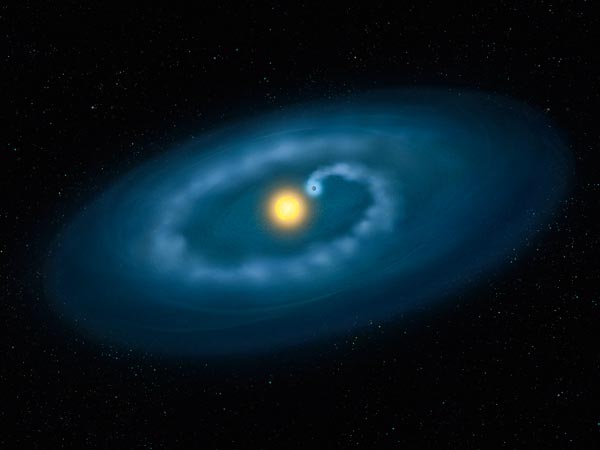Giant Planet Being Blown Away Behind a Cloudy Veil
An illustration shows a planet roughly 1.4 times the size of Jupiter being consumed by its own star.
A star is slowly snuffing the life out of an alien planet. But in a macabre twist, material stripped out of the dying world's atmosphere has become a death shroud enveloping the gas giant and its star.
First discovered in 2008, WASP-12b is a so-called hot Jupiter—a gas giant planet orbiting extremely close to its parent star.
Located 1,100 light-years away, WASP-12b hugs its star so tightly that a year on the planet lasts just over one Earth day. The two objects are so close that scientists think that the gas that makes up most of the doomed planet is being boiled off and blown into space by the intense heat from its star.
"At the current best guess ... the planet will lose most of its mass in about one billion years," said astrophysicist Carole Haswell of The Open University in the United Kingdom. A relative blink of an eye when compared to Earth's projected 9-billion-year life span.
A Celestial Death Shroud
Scientists predicted that this evaporative process would create a superheated gas cloud surrounding Wasp 12b. Such planet-enveloping clouds have been detected around two other hot Jupiters before.
Haswell and her colleagues used NASA's Hubble Space Telescope to find evidence of an extremely diffuse gas cloud surrounding WASP-12b—as they suspected. But the cloud was much bigger than predicted.
"What's new in our work is that we find the whole star-planet system is enshrouded," Haswell said.
Behind the Veil
WASP-12b's gauzy cloak is also unusual in that it appears to be infused with the element magnesium, which absorbs some of its star's light. This renders the entire system invisible when viewed in the near-ultraviolet part of the light spectrum, although the dying planet is otherwise detectable.
"It's like the planet is suffering the sad end of being evaporated away ... and the star has drawn a privacy veil over the whole sordid affair," Haswell said.
Researchers suspect gas clouds surrounding other hot Jupiters may harbor similar cloaking properties, but no one knows for sure.
The Blowoff
Astronomer Helmut Lammer said the new findings are important because they could help reveal the structures and strengths of the magnetic fields of alien planets. This could help scientists compare distant worlds to planets in our own solar system.
"Depending on the magnetic field ... magnesium [atoms] can accumulate in front [of] or around obstacles"—such as in front of the outer edge of a planetary magnetic field, known as the bow shock, said Lammer, of the Space Research Institute of the Austrian Academy of Sciences, who was not involved in the study. And we can detect these features when the planet crosses in front of its star, he added.
Alfred Vidal Madjar, an astronomer at the Paris Institute of Astrophysics, said he thinks the new WASP-12b observations confirm a hypothesized process called "blowoff," in which hydrogen escapes from a hot Jupiter so quickly that other chemical elements—such as magnesium—also get carried off into space.
The presence of magnesium in the gas cloud "strengthen the reality of the 'blowoff' mechanism," said Vidal Madjar, who also was not involved in the study.
Hot Jupiters that orbit as close to their stars as WASP-12b does will almost certainly be cocooned in similar gas clouds, astronomers say. But ones that orbit further away-or orbit cooler stars-likely do not.
Ker Than
for National Geographic News
Published November 21, 2012












